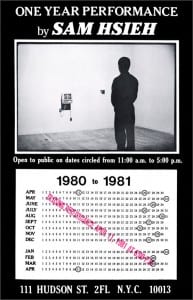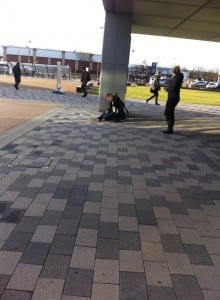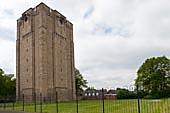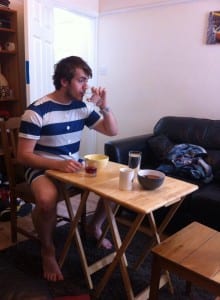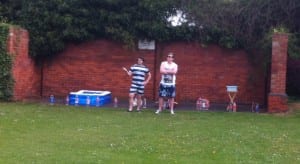A Framing Statement:
Over a matter of 12 weeks myself with a group consisting of Georgia and Beth had to create a piece of site specific performance in a selected location within Lincoln. The location the group and I was given was uphill Lincoln which included the use of steep hill if we wished. We as a group were taken by the ‘secret’ garden located opposite the famous Lincoln Cathedral on our first walk (drift) around the possible site location choices to perform. The ideas I had first in versioned of this bizarre style of performance was linking to “religion” or a “Mad hatter’s tea party”. But the final idea we all agreed on was self-image on how a person sees themselves as well as the history of the Pot makers of Lincoln.
Our performance date was set and ready to be performed on Wednesday 6th May 2015. “Clay Walkers” was an installation as well as a durational piece which also consisted a miniature tour from Pottergate located south of the Cathedral grounds up to the exchange gate near the Lincoln hotel from there down to the garden. The reason why our performance piece was named “Clay Walkers” was because our piece was inspired by Antony Gormley who created the famous “Field of the British isles” https://encrypted-tbn1.gstatic.com/images?q=tbn:ANd9GcS-JmVF8UnKU1BI3r8ytOEMC4HdJPuPMoA1vZhiwDkPnNNSXgkA1v2Uznw. (Gormley, 2012, cited in Zimbio.com)
The piece was made by ground clay figures (210,000) of them. We knew we couldn’t make that many figures on the day so our aim was 200 figures in 8 hours. This was to represent the working day.
As the weeks went by our audience would become more important to the installation piece more than ever. The audience would assist the creating or building up the figures with the clay we provided (that being only a handful of clay) well salt dough. Enabling the performance to have many different looking figures than just a normal same looking figures, which to me seems boring. As human being not one of us are the same in body shape or in mind.
On the day of the performance the weather wasn’t exactly on our side nor the weather we really wanted. It wasn’t fun being out in the pouring rain with salt dough clay turning all sticky and sticking to everything and staining everyone blue (as it had to have a colour change). Sadly the only audience members we had to assist with the creating of the figures were Conan (our second marker for this assessment) and Rachel (our tutor).
With the whole process of this piece this quote has always stood out to me ‘the play-as-event belongs to the space, and makes the space perform as much as it makes actors perform’ (Wiles, 2003, p.1). When I first read it I couldn’t really explain why I liked it until the performance, as actors with site specific you don’t really need to over dramatize the performance. It’s not a play its well Site Specific, let the space (or site) do all the performing like we did as a group.
An Analysis of Process:
To get the final product of performance it didn’t happen overnight it took a lot of planning and ideas before us as a group agreed on a final idea performance. In the first few weeks the module was split up between theory classes and working on location creating some of the performance or at least getting a feel of the location. My first idea before I’d even got into a group to create our performance I wanted to work on the historical side of religion associated with the uphill Lincoln, however on reflection religion isn’t really a site specific performance idea plus it could offend people who believe/ support religion and the church (cathedral) if we had given out wrong information.
The Theory behind Clay Walkers:
As I’ve mentioned before Antony Gormley was the main influence for Clay Walkers, however it wasn’t just his work ethic that inspired the final creation. During the theory seminars with Rachel on Wednesdays we were taught different styles of site specific performances. There are many types of performance that we could have chosen. Some of them I didn’t think at the time were classed as a performance like an audio recording of instructions to be performed by the person listening to them. After this module I’ve accepted lots of other methods for site specific.
Adrian Howell was one the main people we focused on with the audio recordings. For example we listened to Howell’s Everyday Moments 11 http://http//www.theguardian.com/culture/audio/2011/nov/21/everyday-moments-podcast-adrian-howells: (an audio drama for private performance in our own time). Some of the instructions that we were giving were based on how to drink a hot cuppa in bed. It was specially designed for people to participate from the comfort of your own home. This task was one I wasn’t too keen on perusing for the final product. Reflecting back on the overall performance I don’t honestly think Clay Walkers would have worked with an audio recording.
Being one with the performance site location:
“To be a place, every somewhere must lie on one or several paths of movement to and from places elsewhere. Life is lived, I reasoned, along paths, not just in places, and paths are lines of a sort“. (Ingold, 2007, p.2). This quote sums up the main feel for the creation of Clay Walkers. We started with all sorts of ideas and walked many paths around uphill Lincoln to finally get the one that felt right. Also section of this quote stating “Life is lived”, I felt as a group we were reliving the history of the potters from the late 15th century some stories from Pottergate are even older.
Something I wrote from one of my first blog posts back in February “After walking around the cathedral and the secret garden it made me and a couple of friends decide that we felt connected with this site. The garden felt like a place you would enter after you’ve passed like God’s waiting room. I think it’s connected more by religion as the garden is right next to the cathedral’s door to heaven”. (Levesque-Payne, 2015). I have no idea still to this very day why I felt I had to work in the garden. It just felt right from day one like I was drawn to it. I had the same feeling with Pottergate that I had to work there as well. https://www.flickr.com/photos/130446517@N02/16076561893/in/datetaken/?cr a picture of Pottergate taken in February (Levesque-Payne, 2015 cited in Flickr).
Legends and Myths:
Lincoln being an historical city is bound to have local folk tales and legends, well it didn’t fail to disappoint. I was aware of the legend of the Lincoln imp in the cathedral. I was more interested to find out if there was any mythical legends connected with either the garden or Pottergate. Before our final group idea, we had included St Anne’s Well located at the back of the cathedral. Beth had done some in depth research based on the local history and discovered a legend about the devil being connected with the well. Needless to say I wanted to try this myth or theory out in a workshop session when rehearsing up by the cathedral.
“At the rear of Lincoln cathedral stands Queen Anne’s well. A small stone structure, with a pointed roof, the well has one wooden door, with six holes symmetrically placed across the front. Legend states, that if you walk around the well seven times, and then place your finger into one of the holes you will be judged by the devil. If you are a good person, you will feel the devil’s breath on your finger. If you’re bad, it will be bitten off!” (HauntedLincs Blog, 2012). I strongly felt this idea would have been amazing to add into our site piece however on reflection many people get freaked out when it comes to ghosts and witchcraft legends. Georgia and I felt most confident when it came around to testing this local legend out. I’m not going to lie I wanted something to happen but alas nothing happened at all. So I guess this story will forever remain a story.
Over the top performance or minimalistic?
So as a group our first idea of a mad hatter’s tea party was a bit over the top even for site specific. We were advised to look around the space to create a performance. Inside Pottergate on the bricks are engraved names some of which have been graffiti from teens, however upon on rehearsal Georgia and Beth had discovered a very faded out number of 1895 and a name of “P.Pinkering”. It resembled a grave stone marking, was it a date of an original potter’s death or birth? Naturally that got us all thinking ideas and creating a story behind this person (seeing as we were unsure whether this person was male or female).
In our own time each group member did their own research into the gates history, I’d discovered that Pottergate was an entrance to uphill Lincoln to trade your goods at the market which funnily enough is located where the secret garden now stands.
One idea that eventually was discarded was to give a misguided tour from the Pottergate to the garden via St Anne’s Well. While on the tour your guide would give you a set of tasks that you had to perform on the route. Some of the tasks were to see if you’d been good or bad at the well. We as a group had decide to turn down the ritual tasks at the well not to freak the audience members out, turning them out into more of a dance routine. With this misguided tour we were going to have P.Pinkering as our main character, Beth had created a background story saying P.Pinkering was a potter who sadly lost his life. So our misguided tour was to fulfil his/her wish to create an object out of clay and go to market to sell it.
Our reasoning for discontinuing the idea of a misguided tour with P.Pinkering as our main focus because it started turning into a characterised performance taking away the feel of a site specific performance.
“Site Specific performance exists within a plethora of phenomena, all competing for attention, all potentially meaningful: A concatenation of that at site and that brought of the site”. (Pearson, 2010. P.1). I wanted our performance piece to show through the location itself. The beauty of the garden didn’t really need a character to make it feel like a performance.
To use clay or Salt Dough:
Now we have an idea that we as a group want our audience to create a figure of themselves and to create it in the way they see themselves looking to the world. Once they have created a figure, they will walk with one of our trained Potters (Beth, Georgia and myself) to bake the figure in the kiln oven that still exists in the garden wall.
The price of clay varies depending on the amount of clay that is needed. Seeing as we only have a budget of £30 (£10 per person in the group) we have to use our money wisely. Georgia, Beth and me consulted Rachel on what we could use that would have the same effect of clay that we could get that’s cheaper. She suggested salt dough (play dough). There are many ways to make salt dough by either cooking or just making it by hand. The recipe I found online to create our clay was from WikiHow, http://www.wikihow.com/Create-Salt-Dough.
The first time we made the salt dough was the day before our first dress run. It took four hours to create 200 pieces just for dress run. Considering that it’s taken four hours to create that amount, I remembered we would have to create either the same amount or more dough depending on how well the dress run went.
Dress Run:
So the day of the first proper test run of clay walkers had arrived and there was mixed emotions on the task we had put us through. We did have perfect weather which I was praying for. However upon reflection having very hot sunny weather made clay walkers a more difficult process than it should have been. The weather not only affected some of the cast with the onset of heat stroke it also affected the salt dough. Within an hour of running the durational piece the dough started to dry out. So the water we had brought for us to drink was being used on the dough to keep it moist. Due to the weather and health of the cast, I decided to inform Rachel that the dress run had to be cut short, so we only be able to complete four hours of our eight hour performance. This wasn’t clay walkers idea of this perform. However we were pleased that these issues had happened on the dress rehearsal than actually happen on the assessed performance.
Final performance of Clay Walkers:
The final performance took place on a very wet and windy day something we wasn’t hoping for. I know I said that the weather was a problem when it was warmer however I would of preferred it if it was warmer but not too warm. Sadly we couldn’t change or be in control of the weather.
Clay walkers performance lasted six hours as we ran out of clay (salt dough). A few problems we encountered throughout the day was no audience members expect for Conan and Rachel which for me was a really confident boost. Having no audience members attend made the performance a lot more stressful and time seemed to stand still. I think the many reason why we didn’t have any audiences was because of the strong rain. It wasn’t because it wasn’t advertised at all I had full control of the promotion of Clay Walkers on Facebook https://www.facebook.com/pages/Potters-A-Site-Specific-Performance/452974651526779
I would regularly update the fan page as well as the event to keep people informed of our processes to creating our group piece.
One thing we haven’t really taken into consideration was the reactions to the general public around us from tourists to locals. I know site specific is a bizarre style of performance, I don’t really think we helped matters when our clay was wrapped up into balls with cling film around it made it resemble pre-packed bags of drugs. We had this problem in the dress run so decided to change the colour of the mixture to make it look less suspicious to the general public. Sadly on the day of the performance an unforeseen incident occurred between myself and a member of the general public wanting to take the bag we had as storage of the dough away. luckily enough the person didn’t stay long once hearing the sound of police sirens.
Something else that changed half way through the durational piece was the things we were creating down at the Pottergate. Conan wanted the group to use the things we had around us that inspired our emotions with the locations we’d picked. Our final piece (once it was completed) was a memory or though mural dedicated to the history of uphill Lincoln. An image link to the final product : https://www.flickr.com/photos/130446517@N02/16901390364/in/datetaken/ (Levesque-Payne, 2015. Flickr).
Performance Evaluation:
Upon reflection with the performance of clay walkers I felt it could have gone a lot better than it actual turned out. I think we as a group had done a bit more rehearsals on creating things around us than creating self image clay figures we could have created a lot more than we did in the six hours. But saying that the performance wasn’t all doom and gloom as I enjoyed being in a beautiful location even if it was raining the garden still smelt amazing with the wet grass. Still till this very day I have found putting the theory we was taught as a whole class into practise in the location was a struggle. Finding a reading that linked in a way to our piece was a nightmare. The only few times I could link in research to the rehearsals was when I referenced Antony Gormley into our inspirations.
If I was to re-create clay walkers again in the near future I would use wooden chopping boards in the garden only and create bricks with words cut into them with words relating to site specific performance or things I could see around me. I think I would use Pottergate once an hour to collect audience instead of walking in a cycle that way people could enjoy their time in the garden. I also think if we had audience as well involved in clay walkers the reactions would be better than we as a group reacted to each other. It wasn’t until we created and finished the mural that we actually appreciated our hard work in the pouring rain for six hours.
Works Cited:
Gormley, A. (2012) Antony Gormley’s Field For The British Isles Arrives At Barrington Court. [Online] Zimbio.com. Available from http://www.zimbio.com/pictures/U3xR0oAep5R/Antony+Gormley+Field+British+Isles+Arrives [Accessed on 11th May 2015].
Ingold, T. (2000) The Perception of the Environment: Essay on Livelihood, Dwelling and Skills (London, Routledge).
HauntedLincs Blog. (2012) Cathedral: The Ghosts of Lincoln Cathedral. [Blog entry] March 2012. Lincoln: University of Lincoln. Available from https://hauntedhistoryoflincolnshire.blogs.lincoln.ac.uk/lincoln/lincoln-cathedral/ [Accessed 12th 2015].
Howell, A. (2011) Everyday Moments 11: audio drama for private performance. The Guardian. [Online] Available from http://www.theguardian.com/culture/audio/2011/nov/21/everyday-moments-podcast-adrian-howells [Accessed 16th February 2015].
Levesque-Payne, S. (2015) it’s the uphill climb. [Blog entry] 8th February. WordPress: University of Lincoln. Available from https://sitespecific2015rba.blogs.lincoln.ac.uk/wp-admin/post.php?post=215&action=edit [Accessed 8th February 2015].
Levesque-Payne, S. (2015) Final Assessment of “Clay Walkers”. [Online] Flickr.com. Available from https://www.flickr.com/photos/130446517@N02/16901390364/in/datetaken/ [Accessed 14th May 2015].
Levesque-Payne, S. (2015) Sophie Levesque-Payne’s Flickr SAM_1338. [Online] Flickr.com. Available from https://www.flickr.com/photos/130446517@N02/16076561893/in/datetaken/?cr [Accessed 12th May 2015].
Pearson, M. (2010) Site-Specific Performance. London: Palgrave Macmillan.
WikiHow. How to make salt dough. [Online] USA. Available from http://www.wikihow.com/Create-Salt-Dough [Accessed 17th April 2015]
Wiles, D. (2003) A Short History of Western Performance Space. Cambridge: Cambridge University Press.

